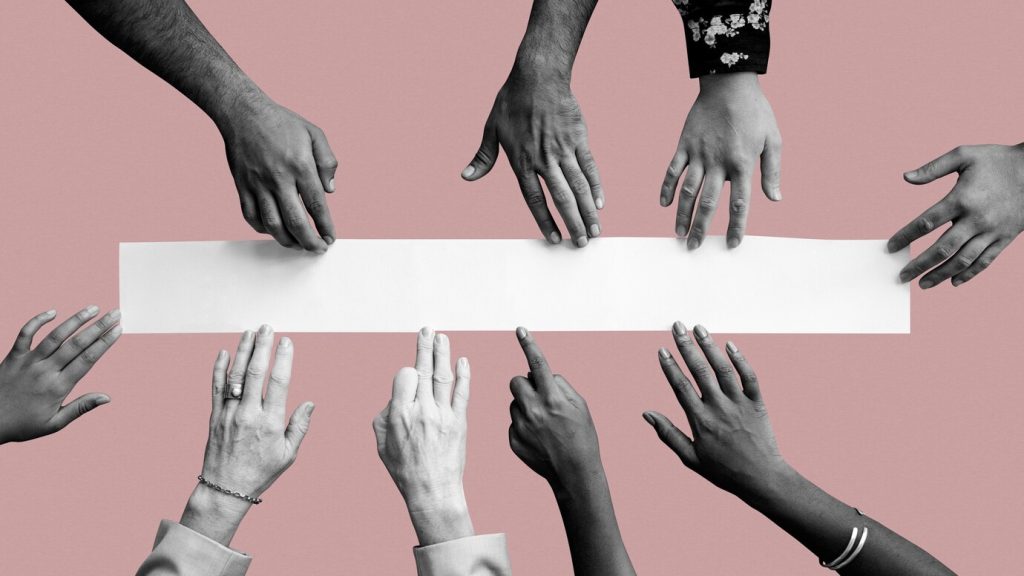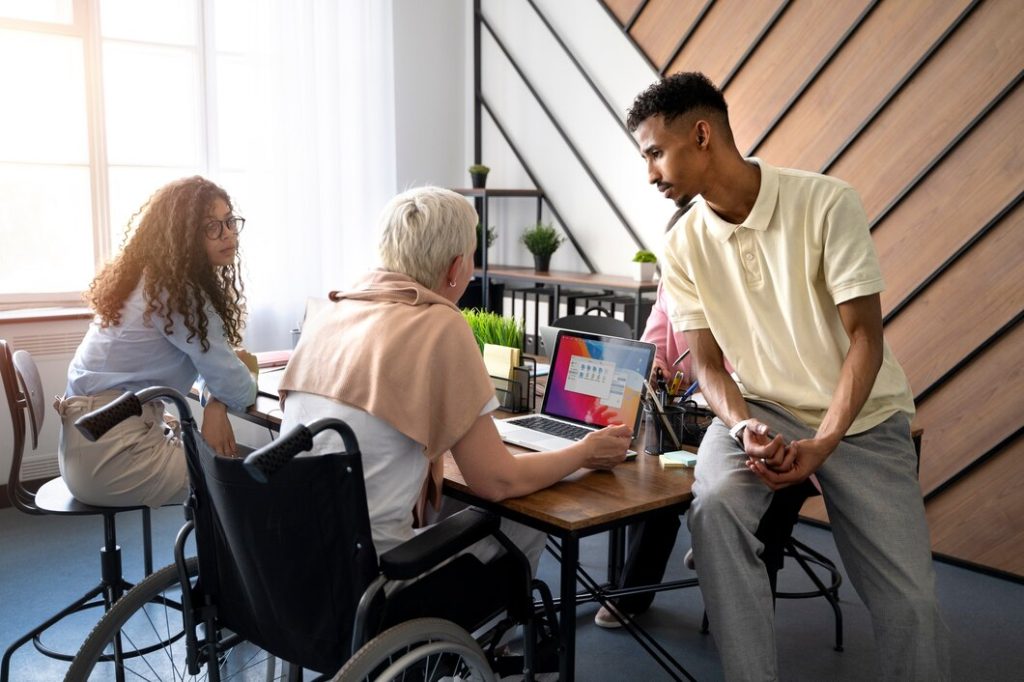Did you know that nearly one in every five people worldwide has a disability? This eye-opening statistic highlights the universal impact of accessible design. Rooted in the 1970s and pioneered by Ron Mace, this philosophy was further refined at North Carolina State University in 1997. It’s a call to action for creating environments that welcome everyone, transcending the limitations of individual abilities.
In today’s world, ‘design for all’ transcends being merely a catchphrase. As a Product Designer, I’ve witnessed its transformative power, not only as a tool for creating inclusive experiences for people with disabilities but also as a catalyst for enhancing usability for everyone.
Take a moment to consider various challenges: a person with low vision, someone recently out of eye surgery, or a parent attempting to read an e-book in a poorly lit room while their child sleeps. Each of these individuals would struggle to engage with text on a digital screen.
Traditional accessible design tends to focus on solutions for permanent visual impairments, often overlooking those with temporary impairments, like the post-surgery individual, and almost certainly ignoring the needs of the parent in the dimly lit room.
Inclusive design, on the other hand, embraces a wider range of circumstances that may impede effective interface use. This method might start with the parent’s need for better lighting, then evolve to include solutions that cater to both permanent and temporary visual challenges. Imagine digital content with adjustable text sizes or a night mode feature with enhanced contrast – these are the kinds of inclusive solutions I’m talking about.
In this blog, I’ll explore the intertwining of accessibility and usability, highlighting the importance of flexibility, adaptability, and simplicity in making products and services universally usable. Join me as we explore the broad benefits of inclusive design, and see how at BrightMarbles Group, we embody this ‘design for all’ philosophy, integrating it into technology that impacts every life.

Clarifying Accessible vs. Inclusive Design in Digital Interfaces
The terms ‘accessible design’ and ‘inclusive design’ are often used interchangeably, yet they encompass distinct principles and objectives. Understanding the nuances between these two approaches is crucial for designers aiming to create products that are truly user-friendly for a broad audience.
Accessible Design: Focusing on Specific Needs
As mentioned, accessible design is primarily concerned with creating digital products that cater to the needs of people with disabilities. This approach is guided by established accessibility guidelines set forth by various governmental and industry groups. The goal is to ensure that people with disabilities can effectively access websites and other digital products. For example, in the case of auditory content, accessible design principles would involve providing assistive features for people who are hard of hearing. However, a key limitation of accessible design is that it may not always consider temporary impairments or situational disabilities.
Inclusive Design: A Broader, Methodological Approach
In contrast, inclusive design adopts a more holistic methodology. It doesn’t just focus on the outcome; instead, it’s about the process of creating a design that can be effectively used by a diverse group of people. This approach begins by examining the diversity of user experiences, actively seeking to identify and address scenarios where individuals might be excluded from using an interface effectively.
Inclusive design recognizes that disabilities occur at the intersection of people and their environments. It acknowledges that solutions beneficial for people with disabilities can have a far-reaching impact, aiding those in diverse circumstances. For instance, subtitles or a transcript for audio content, while aiding those who are hard of hearing, also benefit commuters in noisy environments or non-native language speakers.
To sum up, inclusive design starts with identifying situations where exclusion occurs, understanding that anyone could face barriers depending on their circumstances. This methodology is about designing for all kinds of users, acknowledging the fluidity and variety of user needs in different environments.
Understanding Inclusive Design Principles

Central to this approach are the Inclusive Design Principles, established with a focus on people first and rooted in empathy and inclusion. These principles are designed for the needs of individuals with permanent, temporary, situational, or changing disabilities — essentially, for everyone.
They are intended for anyone involved in the design and development of websites and applications – designers, user experience professionals, developers, product owners, idea makers, innovators, artists, and thinkers – providing a broad approach to inclusive design.
- Provide Comparable Experience: Ensure your interface offers a comparable experience for all, allowing users to accomplish tasks in a way that suits their needs without compromising content quality. Whether it’s alt text, a transcript, or sign language, the content should capture the essence of the original. For example, synchronized closed captions that are customizable and repositionable offer a more comparable experience.
- Consider Situation: Recognize that people use your interface in different situations. Good contrast for outdoor use, context-sensitive help for complex forms, and default captions for mobile use in public spaces are examples of considering situational usage.
- Be Consistent: Utilize familiar conventions and apply them consistently across functionality, behavior, editorial, and presentation. This includes consistent web and platform design patterns, plain language, and consistent page architecture.
- Give Control: People should be able to access and interact with content in their preferred way. Do not suppress standard browser and platform settings and avoid uninitiated content changes. Examples include options to turn off infinite scrolling and allow pinch-to-zoom gestures.
- Offer Choice: Provide different ways for people to complete tasks, especially those that are complex or non-standard. This could mean multiple ways to complete an action, offering layout options, and providing accessible alternatives as a choice for all users.
- Prioritize Content: Help users focus on core tasks and information by prioritizing them within the content and layout. This involves progressively revealing features, prioritizing tasks like “compose” buttons in email applications, and ensuring primary content such as news stories come first visually and in source order.
- Add Value: Features should enhance the user experience by providing efficient ways to interact with content. Integration with device features like voice, geolocation, and vibration APIs, and consideration of connected devices or second screens can add significant value for various users.
At BrightMarbles Group, these principles are the bedrock of our design philosophy. By integrating them, we ensure that our products are genuinely accessible and inviting to all.
The Universal Benefits of Inclusive Design
Inclusive design is widely appreciated because features made for people with disabilities are now commonly used by everyone. Consider voice commands and customizable text sizes; these tools, while initially designed for users with specific needs, have become commonplace, simplifying and improving the digital experience for everyone. Closed captions are another excellent example. Originally developed for the deaf and hard of hearing community, they are now extensively used in various scenarios, such as in loud environments or by individuals learning a new language.
Here, we’ve seen firsthand that incorporating inclusive design elements often leads to broader innovations, which in turn improves the overall user experience. These features have the power to streamline interfaces, boost usability, and make digital interactions more intuitive and satisfying. By prioritizing accessibility in our design process, we aim to assist those with needs, and also to elevate the digital experience for all of our users. This approach underscores the far-reaching impact of inclusive design, demonstrating that when we design for inclusivity, everyone benefits.
Reimagining Accessibility as a Core Investment
A crucial question often arises: what are the costs associated with developing an accessible product compared to a non-accessible one? To put it in perspective, consider how we view the design elements like distinct UI buttons and text styles. These are not mere add-ons; they’re fundamental to user experience, guiding users in identifying interactive elements and their functions.
Similarly, when we think about accessibility, it’s not about extra costs but about redefining who the ‘user’ is. By expanding our perspective to include users with diverse needs and potential limitations, we realize that accessibility is not an ancillary aspect of product design. It’s a core feature, essential for reaching a wider audience and fulfilling the aim of any commercial digital product – to be used by as many people as possible.
So, what are the universal benefits of inclusive design, besides broader usability?
- Increased Market Reach: Inclusive products can appeal to a larger market segment, including the aging population and those with temporary impairments.
- Legal Compliance: It helps in meeting legal requirements, reducing the risk of accessibility-related lawsuits.
- Social Inclusion: It promotes social inclusion and equality, ensuring that technology and environments are usable by people of all abilities and backgrounds.
- Enhanced Brand Image: Implementing inclusive design can improve a company’s reputation and brand image, showcasing a commitment to inclusivity and social responsibility.
- Improved SEO: Many inclusive design practices, like providing alt text for images and ensuring navigable and clear content, can also improve a website’s search engine optimization.
- Cost Efficiency in the Long Run: Designing with accessibility in mind from the beginning can be more cost-effective than making changes later to address accessibility issues.
- Increased Customer Loyalty: By providing accessible products and services, companies can build stronger loyalty among users who appreciate inclusive design.
- Better User Experience for All: Inclusive design often leads to a cleaner, more intuitive user interface, benefiting all users.
Real-World Impact of Inclusive Design
The impact of inclusive design in the real world is profound and far-reaching. Take, for instance, a project we undertook for an e-commerce platform. By implementing keyboard navigation and screen reader compatibility, we made the site more accessible, and improved its overall navigability, leading to a substantial increase in user engagement and satisfaction across the board.
But the impact goes beyond metrics. I recall a user who, due to a motor impairment, struggled with traditional navigation methods. Our inclusive design features enabled them to shop independently online for the first time. This is the kind of real-world difference inclusive design can make – it’s about empowering individuals, breaking down barriers, and creating equal opportunities for everyone.
Let’s look at how inclusive design is making waves:
- Apple’s Accessibility Innovations: Apple has been a game-changer in accessibility. They made iTunes U user-friendly for blind students and introduced VoiceOver on the iPhone, revolutionizing how screen readers work.
- Google’s Accessibility Edge: Google has been mixing things up with accessibility-driven innovations. Features like better contrast, auto-complete, and voice control were designed for people with disabilities, but now, they’re helping everyone.
- NPR’s Transcript Game-Changer: When NPR started transcribing their broadcasts, they didn’t just follow rules. They boosted search traffic and made their content easier to understand for everyone, especially ESL listeners.
- Alt-Text in Images: Adding alternative text to images is a win-win. It’s crucial for users with visual impairments and handy when images don’t load. Plus, it’s great for SEO.
- The Curb Cut Effect: This is about how things made for people with disabilities, like closed captions and automatic doors, have ended up being super useful for everyone.
These examples show how inclusive design doesn’t just help people with disabilities; it makes things better for all of us, sparking new ideas and making our digital world more inclusive.
BrightMarbles’ Approach to Accessibility
At BrightMarbles Group, our stance is clear: every individual should have equal access to digital products. This conviction demands that we no longer treat accessibility as a secondary feature or a ‘nice-to-have’. It must be a foundational element in our strategy, design, and development processes.
Our commitment starts with empathy, where we dive deep into understanding the diverse needs of our users through comprehensive research and consistent interaction. Throughout our design and development stages, we prioritize accessibility checks and audits, ensuring our solutions are inclusive from the ground up.
A key strategy for us is inclusive user testing. We actively involve users with various abilities in our testing phases to gather authentic feedback. This proactive approach enables us to identify and address potential issues early, guaranteeing that our final products are both functional and genuinely aligned with the needs and expectations of all our users.

The Future of Inclusive Design in Tech
As we look to the future, inclusive design in technology holds immense promise. We’re witnessing the rise of AI-driven accessibility tools, voice-first interfaces, and increasingly adaptive technologies that meet a broad spectrum of user needs.
At BrightMarbles Group, we’re passionate about leading these advancements. We’ve reached a juncture in our journey where overlooking accessibility seems not just an oversight but an outright irresponsibility. With all the necessary tools, knowledge, and capabilities at our disposal, we are committed to crafting apps that cater to everyone.
For us, accessibility is a fundamental part of our design ethos, shaping how we envision and create technology for tomorrow.
Conclusion
Inclusive design is a mindset that enhances life for everyone. At BrightMarbles Group, we’re committed to leveraging technology to unite and empower people, with inclusive design as a cornerstone of this vision. Our approach goes beyond creating digital products and services – we’re shaping empowering experiences for all.
Think about how the tech you use every day could be more welcoming to everyone. Got any cool ideas or stories about making tech more inclusive? We’d love to hear them! Let’s all get together to make a digital world that’s welcoming for all. Here’s to creating a future where tech isn’t just powerful – it’s for everyone!
About Author
Mladen Maksimović is our in-house lead product designer in charge of product design development on various softdev projects. He is also a creative director responsible for guiding and supervising our partnership business projects. Best-known for his adeptness at merging UI/UX design, product design, and graphics into trailblazing solutions, Mladen always takes design one step further.
